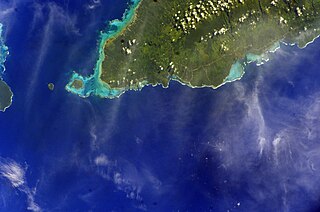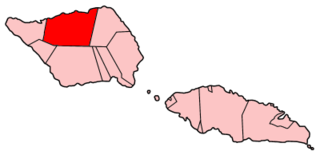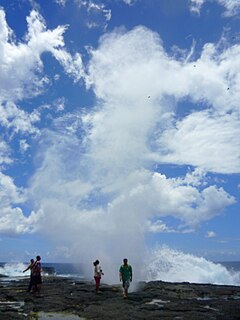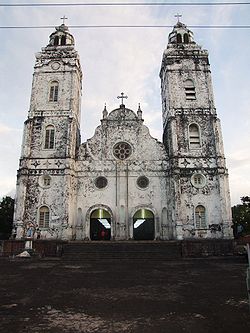
Savaiʻi is the largest and highest island both in Samoa and in the Samoan Islands chain. The island is also the sixth largest in Polynesia, behind the three main islands of New Zealand and the Hawaiian Islands of Hawaii and Maui.
Queen Salamasina was a powerful and high-ranking woman in Samoan social history. She held the four papā (district) titles which gave her the paramount status of Tafa‘ifā on the western islands of Samoa. Contrary to popular belief she was not the first Tafa'ifā, as these titles were willed to her by their previous possessor, Nafanua. She is the titular ancestor of two of the four paramount titles of Samoa, Tupua Tamasese of Falefa and Salani and the Amaile Mataafa line.

Aʻana is a district of Samoa. It is on the western third of Upolu island, with a small exclave surrounded by Aiga-i-le-Tai. It has an area of 193 km² and a population of 23,265. The main centre is Leulumoega.

Gagaʻemauga is a district on the island of Savaiʻi in Samoa. The district is situated on the central north side of Savaiʻi. The name 'Gagaʻemauga' literally means "near side of the mountain", meaning the eastern side of the mountain chain running through the centre of Savaiʻi Island.

Gagaʻifomauga is a political district on the island of Savaiʻi in Samoa. The district is situated on the northern side of the island with a population of 4,878.

Palauli is a district and village of Samoa, with a population of 9,300. It consists of two sections on the southern side of Savai'i. The capital is Vailoa which is also referred to as Vailoa i Palauli.
Le Susuga Malietoa Talavou Tonumaipeʻa was installed as "King" of Samoa to the western world on August 28, 1879 until his death on November 9, 1880. Since Malietoa Talavou's half brother's death, Malietoa Moli in 1860, ongoing wars due to power and authority struggle between Talavou and Laupepa over the next Malietoa title holder and the gaining of support by the districts of Samoa. Family rivalry existed as did a 30-year age difference drew a wedge between Malietoa Laupepa and Malietoa Talavou. They were known to be longtime rivals over the Malietoa title.

Mālietoa is a state dynasty and one of the four paramount chiefly titles of Samoa. Literally translated as "great warrior", the title's origin comes from the final words of the Tongan warriors as they were fleeing on the beach to their boats, "Malie To`a, Malo e tau...".
Matautu is the name of different villages in Samoa. Places named Matautu are found on the two largest islands, Upolu and Savai'i.

Safune is a traditional village district on the central north coast of Savai'i island in Samoa. It lies within the electoral constituency of Gaga'ifomauga. Safune is the birthplace of Mau leader Olaf Frederick Nelson and the filming location of Moana, one of the first documentaries made in the world. The Mata o le Alelo pool associated with the Sina and the Eel Polynesian legend is also in Safune.

Sale'aula is a village on the central north coast of Savai'i island in Samoa and is the traditional center of the Gaga'emauga political district. Chief council meetings are held at Vaitu’utu’u malae in the village. The village has a population of 600.

Safotulafai is a traditional village at the east end of Savai'i island with historical and political significance in Samoa's history. It is the traditional center of the island of Savaii, now became the center of Fa'asaleleaga political district.

Fagamalo is a village situated on the central north coast of Savai'i in Samoa. It is a sub-village or pito nu'u of the larger traditional village enclave of Matautu in the political district of Gaga'emauga. The population of the village is 383.
Tui Fiti or Tuifiti is the name of a figure referred to in different legends in Samoan mythology and in other parts of Polynesia. In other stories, "Tui Fiti" means "high chief of Fiti."

Sapapaliʻi is a village on the north east coast of Savaiʻi island in Samoa. It is the village where John Williams, the first missionary to bring Christianity to Samoa landed in 1830. Sapapali'i is in the Fa'asaleleaga political district and has a population of 896.

Lefagaoaliʻi is a village on the central north coast of Savai'i island in Samoa. The village is in the electoral district of Gagaifomauga 2. The population is 485.

Samauga is a village on the central north coast of Savai'i island in Samoa. It is situated on the central north coast of the island in the district of Gagaʻifomauga and the electoral district of Gagaʻifomauga 2. The population is 373.

Manase is a village on the central north coast of Savai'i island in Samoa in the political district of Gagaifomauga. It has a population of 123.

Archaeology of Samoa began with the first systematic survey of archaeological remains on Savai'i island by Jack Golson in 1957. Since then, surveys and studies in the rest of Samoa have uncovered major findings of settlements, stone and earth mounds including star mounds, Lapita pottery remains and pre-historic artifacts.















